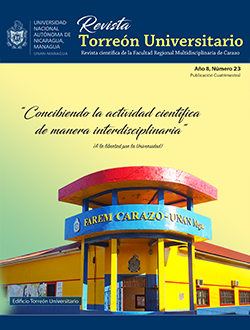Identification and quantification of pesticide residues in vegetables of high consumption commercialized in markets and supermarkets in Managua
DOI:
https://doi.org/10.5377/torreon.v8i23.9532Keywords:
codex alimentarius, maximum residues limits, pesticides, plant matrixAbstract
The use of pesticides for pest control is a common practice in agricultural production systems of Nicaragua. In this study 21 pesticides (7 organophosphorus insecticides, 1 organochlorine insecticide, 3 pyrethroid insecticides, 7 herbicides and 3 fungicides) were studied and determined in samples of tomatoes, peppers, lettuce and cabbage collected in 2 popular markets and 2 supermarkets of Managua. The analysis reflects that 55,0% of the samples contain pesticides, managing to identify residues of chlorpyrifos, mocap, cypermethrin, chlorothalonil, imazalil, diazinon, deltamethrin, simazine and 2,4-D, in concentrations between 0,005 mg/kg up to 5,3 mg/kg. 20,0% of the samples contain residual variables that exceed the values established in the Codex Alimentarius in the matrices lettuce (diazinon), cabbage (chlorpyrifos and diazinon), tomato (mocap and deltamethrin).
Downloads
Downloads
Published
How to Cite
Issue
Section
License
The authors who publish in this journal agree to the following terms.
- The author or authors of the articles, essays or research grant the National Autonomous University of Nicaragua, Managua (UNAN-Managua) the editing rights (copyright) of the submitted work, therefore the University has the exclusive right to publish the article for the entire copyright period.
- These copyrights/authors authorize Torreón Universitario Magazine and the University to edit and disseminate/publish the article in said Magazine, including printed and electronic reproduction, storage, retrieval and any other type of publication, and sources of secondary information as services. of summaries and databases, they also empower it to protect the article against unauthorized use for dissemination by printed or electronic media (PDF, HTML, EPUB, XML or others).
License for use of content
The magazine uses the Creative Commons Attribution-NonCommercial-NoDerivs 4.0 International License.
Under this statement:

This journal is licensed under a Creative Commons Attribution-NonCommercial-NoDerivatives 4.0 International License. It can be copied, distributed and transmitted publicly as long as the author and source are cited (Revista Torreón Universitario), it should not be modified or used for any commercial purpose. The full license can be found at http://creativecommons.org/licenses/by-nc-nd/4.0/.



